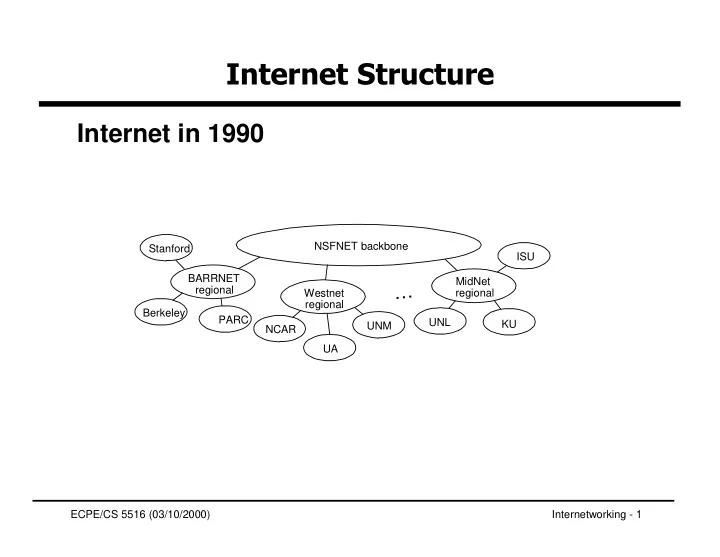

������������������ Internet in 1990 NSFNET backbone Stanford ISU BARRNET MidNet … regional Westnet regional regional Berkeley PARC UNL KU UNM NCAR UA ECPE/CS 5516 (03/10/2000) Internetworking - 1
���������� ■ Add another level to address/routing hierarchy: subnet ■ Subnet masks define variable partition of host part ■ Subnets visible only within site Network number Host number Class B address 111111111111111111111111 00000000 Subnet mask (255.255.255.0) Network number Subnet ID Host ID Subnetted address ECPE/CS 5516 (03/10/2000) Internetworking - 2
�������������� Subnet mask: 255.255.255.128 Subnet number: 128.96.34.0 128.96.34.15 128.96.34.1 H1 R1 Subnet mask: 255.255.255.128 128.96.34.130 Subnet number: 128.96.34.128 128.96.34.139 128.96.34.129 H2 R2 H3 128.96.33.1 Forwarding table at router R1 128.96.33.14 Subnet Number Subnet Mask Next Hop Subnet mask: 255.255.255.0 128.96.34.0 255.255.255.128 interface 0 Subnet number: 128.96.33.0 128.96.34.128 255.255.255.128 interface 1 128.96.33.0 255.255.255.0 R2 ECPE/CS 5516 (03/10/2000) Internetworking - 3
�������������������� D = destination IP address for each entry (SubnetNum, SubnetMask, NextHop) D1 = SubnetMask & D if D1 = SubnetNum if NextHop is an interface deliver datagram directly to D else deliver datagram to NextHop ■ Use a default router if nothing matches ■ Not necessary for all 1s in subnet mask to be contiguous ■ Can put multiple subnets on one physical network ■ Subnets not visible from the rest of the Internet ECPE/CS 5516 (03/10/2000) Internetworking - 4
������������������������� ■ Flat versus Hierarchical Addresses ■ Inefficient use of Hierarchical Address Space ● class C with 2 hosts (2/255 = 0.78% efficient) ● class B with 256 hosts (256/65535 = 0.39% efficient) ■ Still Too Many Networks ● routing tables do not scale ● route propagation protocols do not scale ECPE/CS 5516 (03/10/2000) Internetworking - 5
������������ ■ Supernetting is used to aggregate routes ● Assign block of contiguous network numbers to nearby networks ■ Called CIDR: Classless Inter-Domain Routing ■ Restrict block sizes to powers of 2 ■ Use a contiguous bit mask (CIDR mask) to identify block size ■ All routers must understand CIDR addressing ● Routing involves longest prefix match ECPE/CS 5516 (03/10/2000) Internetworking - 6
����������������� ■ Know a smarter router hosts know local router ● local routers know site routers ● site routers know core router ● core routers know everything ● ■ Autonomous System (AS) corresponds to an administrative domain ● examples: University, company, backbone network ● ■ Two-level route propagation hierarchy interior gateway protocol (each AS selects its own) ● exterior gateway protocol (Internet-wide standard) ● ECPE/CS 5516 (03/10/2000) Internetworking - 7
Recommend
More recommend